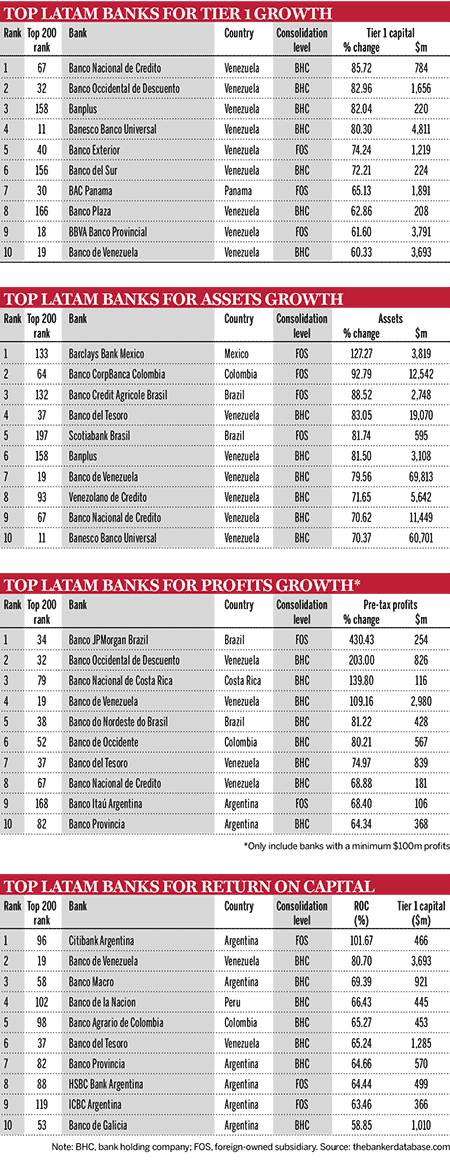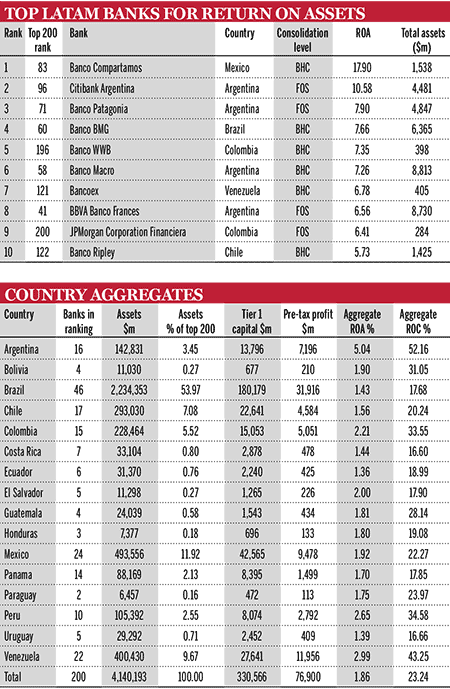Блог им. niregun
крупнейшие банки Лат Ам
- 15 декабря 2015, 00:41
- |
Для дальнейшей покупки бондов нашел статью про рейтинги банков Латама в разных ипостасях. Из журнала the banker, коий платный скачал по временному доступу. Нужная мне суть: Бразильские банки продолжают занимать верх рейтинга, даже не смотря на снижения капитала 1 уровня у топ 5.
Итак рейтинг топ5: Itau, Banco de Brasil, Banco de bradesco. Caixa economica Federal (№4) снизила капитал на 11.79%, Banco Sanrader Brasil (№5) на 18.34%. Оригинал статьи ниже:
Latin American and Caribbean economies endured a tough 2014. Growth in regional gross domestic product was just 1.3% and this poor performance is expected to continue into the current year with growth dipping below 1%, according to the International Monetary Fund (IMF). Falling commodity prices and political uncertainty are taking their toll.
This downturn is driven primarily by Argentina, Brazil and Venezuela. In the first two countries, the economy has stagnated in the past 12 months and the IMF expects them to tip into recession by the end of 2015. The downturn has been more pronounced in Venezuela, where the economy contracted by 4% in 2014 and is expected to fall by another 7% this year. However, banks from these three countries have performed well relative to their regional peers, gathering the most accolades in this year’s Top 200 Latin American banks ranking.
Staying strong
Brazilian banks continue to sit atop the ranking, even though all top five lenders in the country show drops in their Tier 1 capital ratios. The first three positions remain unchanged, with Itaú Unibanco Holding staying in the lead. Banco do Brasil and Banco Bradesco follow in second and third positions, respectively. Despite an 11.79% drop in its capital ratio, Caixa Economica Federal secured fourth spot as the previous incumbent, Banco Santander Brasil, posted an even larger capital decline of 18.34%.
Brazilian banks continue to sit atop the ranking, even though all top five lenders show drops in their Tier 1 capital ratios
Brazil is not all about banking giants – the smaller, foreign-owned lenders also posted impressive results. Banco Credit Agricole Brasil increased its assets by a hefty 88.52% and Canadian lender Scotiabank, which has been pursuing growth strategy in South America for several years now, also showed a balance sheet expansion, with 81.74% growth. Additionally, the US-owned Banco JPMorgan Brazil can boast the highest profit increase in the ranking – pre-tax profits at the bank increased by 430.43%.


As with last year’s ranking, Argentinean lenders stand out in terms of profitability – the country has by far the highest return on capital (ROC) and return on assets (ROA). Partly thanks to the high-interest-rate environment, 2014 was even more lucrative than 2013 for many. Citibank Argentina, a US-owned institution, posted a 101.67% ROC, the highest in the ranking, up from 70.26% in 2013. At 10.58% the bank also showed the second highest ROA in the overall ranking, up from 8.49% the year before. Other notable performers include Banco Patagonia, which shows the third highest ROA and 10th highest ROC overall, and Banco Macro, which ranks sixth by ROA and third by ROC.
Confusion in Venezuela
The performance of Venezuelan banks is harder to judge, as a convoluted system of capital controls complicates the picture. At the end of 2014, the country used two official exchange rates and in this ranking the lower rate of 6.28 bolivars per dollar was used.
Accordingly, the Venezuelan institutions dominate the top 10 for Tier 1 capital growth and to a lesser extent the top 10 for asset growth. Venezuelan Banco Nacional del Credito posted an 85.72% Tier 1 increase, the highest in the entire ranking. The Venezuelan unit of Spanish lender BBVA is also an interesting case. BBVA Banco Provincial showed a 61.6% Tier 1 capital increase in 2014, the ninth largest increase in the ranking. However, when reporting the first-quarter results in April 2015, the bank decided to shift to a third exchange rate system called Simadi, which was introduced in February this year. This system trades bolivars 93% lower than the previous exchange rate, but provides a more accurate view of the franchise from the parent bank’s perspective, given the constrained flow of funds from Venezuela.
Panamanian lender BAC Panama stands out in the Venezuela-dominated top 10 for capital growth. The Colombian-owned bank posted a 65.13% capital increase as the parent successfully integrated its recent acquisitions, Guatemala’s Grupo Reformador and BBVA Panama, into its Panamanian unit.
Two Mexican institutions bucked the trend in this year’s ranking. Although total banking assets dropped in the country as a whole, Barclays Bank Mexico posted a 127.27% balance sheet increase, marking the largest asset expansion in the ranking. Another notable case was Banco Compartamos, also from Mexico. Although aggregate ROA for the country dropped relative to 2013, this lender managed the highest return on assets in the region of 17.9%.
The Banker's Top Latam banks ranking, 2015 originally appeared in the November 2015 issue of the magazine. The full results of the ranking are available on The Banker Database. Find out more about the database, register for a free trial or subscribe today.
- 15 декабря 2015, 00:47

- 15 декабря 2015, 01:13

- 15 декабря 2015, 01:15

- 15 декабря 2015, 01:28

- 15 декабря 2015, 01:31

- 15 декабря 2015, 01:33

- 22 декабря 2015, 01:32

теги блога Коля Гаврилов
- agn
- amzn
- Brent
- commodity
- DJIA
- Dow Jones
- EEM
- EM
- eurobonds emerging markets
- FANG
- fb
- FCX
- GAZP Газпром
- GLD
- Gold
- goog
- ibb
- interactive brokers
- LCI
- NASDAQ
- nflx
- NYSE
- Oil
- pfe
- portfolio managment
- REIT
- RSI Индикатор
- RSX
- S&P500
- S&P500 фьючерс
- Smart Money
- spy
- USA
- value
- value investing
- VNQ
- WTI
- xle
- xlv
- американские акции
- американский рынок
- банки
- Беларусь
- бонды
- Бразилия
- вопрос
- вэлью
- вэлью инвестирование
- Газпромнефть
- гуру
- дивиденды
- долгосрочное инвестирование
- Доу Джонс
- ДСП
- евробонды
- еврооблигации
- етфы
- защита капитала
- золото
- инвестирование в акции
- инвестиции в недвижимость
- инвесторы
- Инсайд на бирже
- Крамер
- крэш
- лонг - на все
- лосейник
- Лукойл
- маилру
- МКБ облигации
- моментум
- Норникель
- Облигации
- околорынок
- Париж
- поздно
- портфель
- портфель активов
- пут опцион
- ржач
- риск офф
- риски
- РТС
- сбербанк
- система
- ситуационный анализ
- ситуация
- СП500
- сп500 к новым вершинам
- сургут преф
- тайминг
- теракт
- торговые сигналы
- трейдинг
- тренд
- угар
- ФРС
- фьючерс ртс
- хэдж
- Щадрин




















